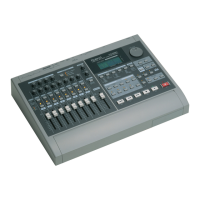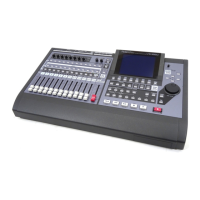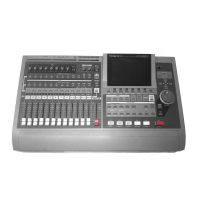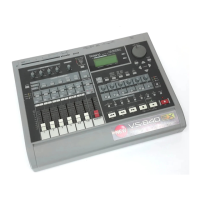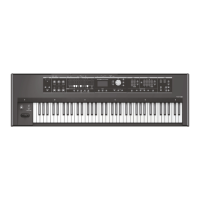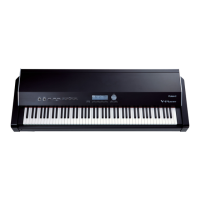15—FX and Aux Busses and Direct Paths
208 www.Roland.com Roland VS-2000 Owner’s Manual
When Would You Use a Direct Path?
Wherever you might use an Aux bus to carry a single signal somewhere, you can just as
easily use a Direct path—this’ll save your Aux busses for other tasks. You can route a
Direct path to an output jack (Chapter 21) on its way to an external device such as an
external digital recorder, effect processor or computer. You can send the VS-2000’s
metronome output as a click track to a drummer’s headphone amp using a Direct path.
External Insert-Like Effects
While you can’t directly insert an external effect into an input, track or FX return
channel, you can use a Direct path to accomplish much the same result:
1. Configure a Direct path so that it accepts the channel’s signal post-fader (Page 209).
2. Route the Direct path to a digital output—see Chapter 21 for details.
3. Connect the input of the external processor—or a computer with an effect plug-
in—to the digital output to which you’ve routed the Direct out.
4. Assign the desired input, track or FX return channel to the Direct path (Page 154).
5. Turn off the channel’s CH EDIT MIX parameter to remove it from the main mix.
6. Return the external processor’s—or computer’s—output to one of the VS-2000’s
digital inputs. (See Chapter 9.)
7. Select the digital input as the VS-2000’s master clock (Page 136).
8. Send the input channel’s signal into the MASTER mix or to a track (Chapter 12).
Sending a Signal to a Direct Path
Send an input or track channel’s signal to a Direct path from the channel’s CH EDIT
VIEW screen—see Page 154. Page 229 describes sending an effect to a Direct path.
Direct Path Levels
While each Direct path’s level is nominally a carbon copy of the input, track or FX
return channel signal it carries, you can adjust the final level of a Direct path on its
MASTER EDIT configuration screen, as described in “Configuring a Direct Path” on
Page 209. This can be helpful if you’re sending a channel’s signal somewhere else in
addition to the Direct path, or to multiple Direct paths.
Metering Direct Path Levels
You can see each Direct path’s level on in the AUXDIR meters on the VS-2000’s home
page. See Page 205 to learn how to view these meters.
When you send an FX return channel’s stereo signal to a Direct path, its left and right
sides are mixed together in the mono Direct path.
When you send a channel’s signal to a Direct path, it’s done using a simple on/off
switch. There’s no separate send level control for sending the signal to a Direct path.
VS2000OMUS.book 208 ページ 2004年10月20日 水曜日 午後3時3分

